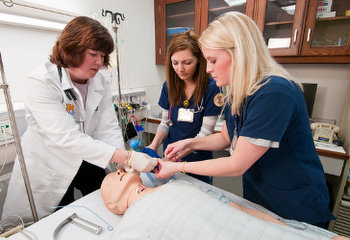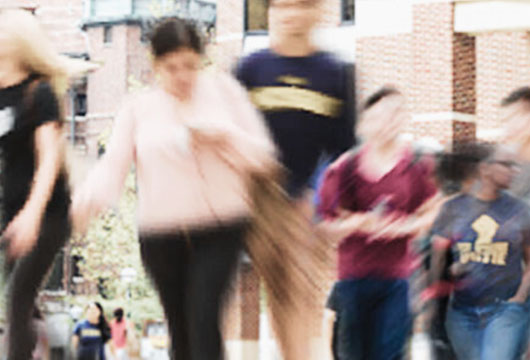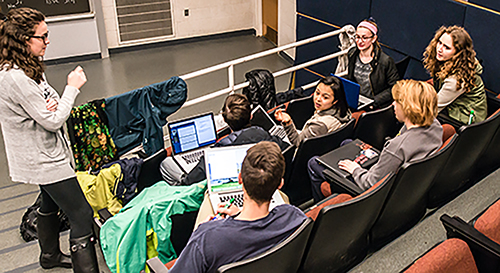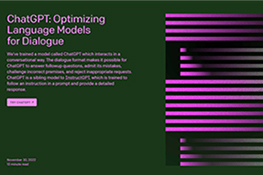March 10, 2014
0 comment
crlt
Engaged learning is a key focus of University of Michigan's teaching efforts, given the power of active, immersive approaches for promoting student learning. Service-learning, fieldwork, and other forms of what is often called 'experiential learning' allow students to make discoveries about course content, connect realms of knowledge and experience, and think critically about their own actions.
Given the practical and logistical challenges often involved in setting up such experiential learning opportunities, how can instructors maximize the student learning that results? Several questions can be useful to consider carefully while planning such a student experience: What kinds of preparation will help students reap the greatest learning rewards of such activities? How can an instructor best connect an immersive activity to the learning goals of the course? How can the teacher effectively prompt students to reflect on their experience to promote learning?

At the U-M School of Nursing, Clinical Assistant Professor Michelle Aebersold has led the way with integrating a powerful form of experiential learning—care for simulated patients—into the undergraduate curriculum, paying careful attention to all of those questions. In this video, Aebersold explains how she structured the simulations to enable nursing students at the Clinical Learning Center to practice key skills and apply their knowledge in a realistic but controlled environment. In these exercises, a few students interact with a state-of-the-art, high-fidelity mannequin or live simulated patient while instructors behind a two-way mirror control the patient responses (breathing and heart rate, for example). Classmates observe the activities through live closed-circuit video.
Discussing the key components that make these simulations powerful learning activities, Aebersold highlights three elements that research supports as good practice for any kind of experiential learning:

1. Pre-learning. In the simulations, nursing students complete activities that prepare them with the background knowledge necessary to successfully engage in the patient care simulations. For example, if the simulations are focused around a case of heart failure, students would study articles about current evidence-based practices pertaining to heart failure, explore specific communication techniques that they will need to use, or practice a set of skills related to the care of patients in these types of situations. Before the simulation, instructors can then assess their students’ readiness by quizzing them and discussing any questions or concerns that come up.
In any experiential learning exercise, such pre-learning activities can help students hone a subset of skills they will need to be successful in the simulation. By focusing students' preparation and checking for readiness before the experience, teachers can minimize problems that might derail the exercise. This is not to say that these experiential learning moments should be so scripted as to eliminate any chance of failure or unexpected challenge; rather, by preparing students with important background knowledge, instructors can help keep the experience focused on the learning goals of the course.
2. Guided observation. A central component of Aebersold's simulations is observation by non-participating students. Through a structured observation form, students are instructed on what to look for as they watch their peers engage in the simulation. After the simulation, these students actively participate in a full-group debrief session, and they are held accountable for their engaged observation of the simulation.
A similar process can be utilized in any course where a subset of students are presenting or participating in an experience. As a teacher, it can be easy to focus attention only on those students on the spot at a given moment. But by thinking carefully about what other students should be doing while watching, teachers can engage everyone in the room in active learning even when not everyone is on "center stage."
3. Reflection. Finally, in Aebersold's simulation-based lessons, all of the students—both those who participated in the simulation and those who observed—are given a chance to reflect together on the activity. The students collaborate to think critically about their decisions and what they might do differently in another situation.
In other courses, student reflection about learning might involve writing a journal, filling out a self-assessment form, or debriefing with a partner. Whatever form it takes, research has found that such opportunities for reflection are key to promoting learning gains from service-learning activities--an insight that readily extends to all experiential courses and assignments. The AAC&U's publications on High-Impact Educational Practices highlight experiential learning and emphasize the central importance of building in opportunities for students to reflect upon what and how they learned. Such reflection enables students to make connections between the instructional and experiential elements of a course, to contextualize and make meaning of that learning, and to consider how such learning might be applied in different settings.
Interested in learning more? On March 15, Aebersold will be giving a talk at the TEDxUofM Against the Grain event at the Power Center for Performing Arts. Her talk, "One Patient ... So Many Lives" will focus on her work designing the simulations.
To read further about experiential learning, see this page of resources and strategies for helping students learn by doing. To see additional examples of experiential learning at the University of Michigan, visit the Michigan’s World Class website, which highlights some of the most innovative teaching happening on campus and off.
Photo Credit: Austin Thomason, Michigan Photography
- Log in to post comments
- 216 views








